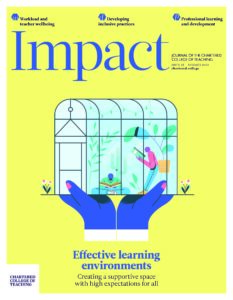Equity and English as an additional language: Looking beyond deficit and asset lenses

Jacob Huckle, Head of EAL at an international school; part-time doctoral student, University of Bath, UK
According to the latest school census, 19.3 per cent of students in England’s schools are learning English as an additional language (EAL), which is around 1.6 million students (Explore Education Statistics, 2021). Although there is no specific data, it’s probable that a large proportion of the 5.68 million students in English-medium international schools around the world (ISC Research, 2021) have English as an additional language. The number of EAL students in both contexts will likely continue to increase.
How do teachers view these students? When they look at their EAL students, do they see their flaws, weaknesses or ‘gaps’? Do they see what students lack? Do they see problems to fix? This kind of ‘narrow focus on what students do not have or cannot do’ (Wang, 2021, p. 2) has been termed a deficit view, a deficit mindset, a deficit approach or a deficit lens. To view students through such a lens is to ‘posi[t] that the student who fails in school does so because of his/her internal deficits or deficiencies’, including ‘linguistic deficiencies’ (Valencia, 2010, p. 6).
Viewed through a deficit lens, the label ‘EAL‘ signifies lack: a lack of vocabulary needed to learn, a lack of confidence to participate in learning, a lack of academic language skills. In this way, students are viewed as ‘broken‘ and the teacher’s role is to ‘fix‘ them. As such, the road to improvement lies in questions such as: What are the students’ gaps? How can we fill those gaps? How can we change the student to adapt to our school?
Although they persist, these deficit mindsets are thankfully becoming less common in the EAL field, especially because much has been written about the importance of replacing deficit-based with asset-based approaches that emphasise students’ strengths, their potential and what they can do. As Snyder and Fenner (2021, p. 75) summarise, multilingual learners (MLs) ‘and their families bring multiple strengths with them; it’s our job to uncover these strengths and incorporate them into MLs’ education’. We know that ‘schools and districts that view language and culture as valuable assets, rather than problematic deficits, tend to create positive environments that are more conductive to [EAL students’] success’ (Fenner, 2014, p. 141).
Viewed through an asset lens, we see the many valuable contributions that EAL students can make and the potential that they bring to our classroom. WIDA (2019), for example, categorises these assets as linguistic, cultural, experiential, and social and emotional:
- Linguistic assets: As multilinguals, EAL students can think in multiple ways and have developed metalinguistic awareness by learning multiple languages
- Cultural assets: EAL students can navigate different sociocultural contexts and can draw upon their cultural backgrounds to bring different perspectives to the classroom
- Experiential assets: EAL students can draw upon varied life and educational experiences as they approach learning
- Social and emotional assets: EAL students are often able to build relationships across boundaries and may have developed resilience and empathy through their experiences.
The teachers’ job is to leverage these strengths, to unlock these potentials, to tap into these assets. The assets-based road to improvement is through asking questions such as: How can I access students’ strengths? How can I build on what students can already do? How can I make connections with students’ other languages and cultures? In these ways, we, as Honigsfeld et al. (2021, p.14) put it, seek to ‘amplify the talents, spirits, and personal powers of MLs’.
For Honigsfeld et al. (2021, p. 15), the classroom is like a garden: just as a garden ‘is filled with such a stunning array of different types of plants, trees, shrubs, and flowers’ and ‘needs to be tended, nurtured, and sown by those who care for it’, so is the classroom filled with the ‘remarkable, varied, and rich cultural and linguistic experiences’ that multilingual learners bring to our classrooms. For EAL students to flourish, we need to tend, nurture and sow those assets.
As such, asset-based approaches are often presented as the opposite of deficit-based approaches. Zacarian and Fenner (2020), for example, argue that the replacement of deficit-based with assets-based approaches is an essential and urgent shift for English learners’ success, and they provide insightful guidance on how teachers and schools can make such a shift.
However, in racial equity training through the organisation the Equity Literacy Institute (Paul Gorski, 2021) argues that the opposite of a deficit ideology is not an asset ideology (as important as that is) but a structural ideology or, in other words, an equity lens. Although he is writing in relation to a different context, I think that this suggestion is also helpful when thinking about EAL (and, of course, linguistic (in)equity often intersects with racial (in)equity).
Whereas deficit and asset lenses both often focus on the individual – the student and their perceived deficiencies or strengths – the equity lens focuses on the systems and structures within which that individual is placed (see Figure 1). If we understand educational equity as meaning ‘that every child receives whatever she/he/they need to develop his/her/their full academic and social potential and to thrive, every day’ (Aguilar, 2021, p. 6), then viewing EAL students through such a lens shifts our focus towards the responsibility of schools and educational systems to provide what they need.

This organisational responsibility is obscured by the deficit lens that ‘“blames the victim” for school failure instead of examining how schools are structured to prevent poor students and students of color [and EAL students] from learning’ (Valencia, 2010, p. xv). Similarly, systemic and structural failings can be missed if, when looking through an asset lens, we focus on students’ talents and strengths without attending to the systems and structures that keep those assets hidden or suppressed. With an equity lens, we position ‘structural inequities’ rather than individuals ‘as the subjects of scrutiny’ (Wang, 2021, p. 2).
Scrutinising and tackling educational inequity ‘requires an understanding of the underlying root causes of disparities’ and ‘involves the promotion of justice and equality of opportunity and outcomes within the procedures, processes and distribution of resources’ (ACF, 2019, p. 13). With an equity lens, we consider how the procedures, processes and distribution of resources in our school impact the progress of EAL students.
The OECD (2008, p. 2) similarly highlights three areas that impact educational equity: ‘the design of education systems, practices in and out of school, and how resources are allocated’. To seek improvement for EAL students through an equity lens is to ask whether the design of my school, our processes and the way in which we allocate resources help or hinder their development towards reaching their full potential. We might ask, for example:
- Are EAL programmes set up and administered effectively to ensure inclusionAn approach where a school aims to ensure that all children are educated together, with support for those who require it to access the full curriculum and contribute to and participate in all aspects of school life and access to the curriculum?
- Is data used intentionally to track and promote EAL students’ progress?
- Are opportunities planned for EAL students to maintain their mother tongues and build on knowledge that they have already gained in other languages?
- Are well-qualified staff employed to take responsibility for leadership and delivery of EAL programmes, as they would be in other subject areas?
- Are all teachers trained in strategies to support EAL students in accessing the curriculum through English and to develop academic English alongside learning subject content?
- Are EAL classrooms well-resourced and inviting environments?
- Are systems in place to communicate with EAL students’ families, even when they cannot communicate in English?
- Are counselling and other socio-emotional support services available to EAL students in other languages?
- Is the curriculum regularly revised to ensure that it is culturally and linguistically relevant?
- Are teachers well informed about research in language learning, the value of multilingualism and pedagogical approaches such as translanguaging?
- Are EAL policies up to date and rooted in current best practice?
- Are suitable, challenging qualifications available for EAL students?
Asking such questions and taking an equity lens when we consider EAL students is the first step towards building more inclusive and equitable schools that are systemically and structurally designed to enable all learners, including EAL students, to flourish. To do this is to treat ‘language education as a social justice issue’ (Cleave, 2020, p. 10). As Nordmeyer et al. (2021) write:
Multilingual learners can no longer be the few students in the back of the room, whose ideas we’ll tap into later when they’re able to share them with us in English. Their participation in class discussions and critical thinking processes is an increasingly important element of our shared future. We will need students with the cultural, linguistic, and intellectual flexibility to be able to cross borders, bridge communities, and help solve the global crises we face – whether climate change, ethnic conflicts, or perhaps the next pandemic.
To make this vision a reality, we need to move beyond a focus on individual EAL students and their deficiencies, and even move beyond just attending to their strengths, and instead focus on fighting inequities and building more equitable schools.
- Aguilar E (2021) Coaching for Equity: Conversations that Change Practice. New Jersey: Jossey-Bass.
- Association of Charitable Foundations (ACF) (2019) Diversity, equity and inclusion: The pillars of stronger foundation practice. Available at: www.acf.org.uk/common/Uploaded%20files/Research%20and%20resources/Stronger%20foundations/ACF_DEI_Thepillarsofstrongerfoundationpractice_final.pdf (accessed 1 December 2021).
- Cleave E (2020) Language, education and social justice: International strategies for systems change in multilingaul schools. Available at: https://www.bell-foundation.org.uk/app/uploads/2020/06/Churchill-Report-2020-FV-web.pdf (accessed 10 January 2022).
- Explore Education Statistics (2021) Schools, pupils and their characteristics. Available at: https://explore-education-statistics.service.gov.uk/find-statistics/school-pupils-and-their-characteristics (accessed 1 December 2021).
- Fenner DS (2014) Advocating for English Learners: A Guide for Educators. London: Corwin.
- Gorski P (2021) Chapter 5: Six Conceptual Tools for Racially Equitable Educators and Schools. In Racial Equity & Education: Informing Ourselves, Transforming Our Schools (Online Course). Available at: https://www.equitylearn.com/courses/racial-equity (accessed 10 October 2021).
- Honigsfeld AM, Dove MG, Cohan A et al. (2021) From Equity Insights to Action: Critical Strategies for Teaching Multilingual Learners. London: Corwin.
- ISC Research (2021) Data on international schools. Available at: https://iscresearch.com/data (accessed 1 December 2021).
- Nordmeyer J, Boals T, MacDonald R et al. (2021) What does equity really mean for multilingual learners? ASCD. Available at: www.ascd.org/el/articles/what-does-equity-really-mean-for-multilingual-learners (accessed 1 December 2021).
- Organisation for Economic Co-operation and Development (OECD) (2008) Policy brief: Ten steps to equity in education. Available at: www.oecd.org/education/school/39989494.pdf (accessed 1 December 2021).
- Snyder S and Fenner DS (2021) Culturally Responsive Teaching for Multilingual Learners: Tools for Equity. London: Corwin.
- Valencia RR (2010) Dismantling Contemporary Deficit Thinking: Educational Thought and Practice. Oxon: Routledge.
- Wang S, Lang N, Bunch GC et al. (2021) Dismantling persistent deficit narratives about the language and literacy of culturally and linguistically minoritized children and youth: Counter-possibilities. Frontiers in Education 6: 1–19.
- WIDA (2019) The WIDA can do philosophy. Available at: https://wida.wisc.edu/sites/default/files/resource/WIDA-CanDo-Philosophy.pdf (accessed 1 December 2021).
- Zacarian D and Fenner DS (2020) From deficit-based to assets-based. In: Calderón ME, Dove MG, Fenner DS et al. (eds) Breaking Down the Wall: Essential Shifts for English Learners’ Success. London: Corwin, pp. 1–20.










